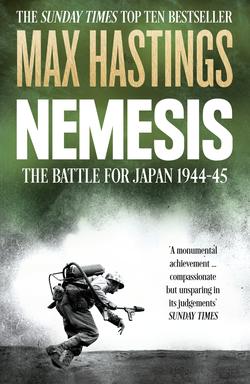Nemesis: The Battle for Japan, 1944–45

Реклама. ООО «ЛитРес», ИНН: 7719571260.
Оглавление
Max Hastings. Nemesis: The Battle for Japan, 1944–45
Nemesis. MAX HASTINGS
Copyright
Praise
Epigraph
Introduction
1 Dilemmas and Decisions. 1 WAR IN THE EAST
2 SUMMIT ON OAHU
2 Japan: Defying Gravity. 1 YAMATO SPIRIT
2 WARRIORS
3 The British in Burma. 1 IMPHAL AND KOHIMA
2 ‘THE FORGOTTEN ARMY’
4 Titans at Sea. 1 MEN AND SHIPS
2 FLYBOYS
5 America’s Return to the Philippines. 1 PELELIU
2 LEYTE: THE LANDING
6 ‘Flowers of Death’: Leyte Gulf. 1 SHOGO
2 THE ORDEAL OF TAFFY 3
3 KAMIKAZE
7 Ashore: Battle for the Mountains
8 China: Dragon by the Tail. 1 THE GENERALISSIMO
2 BAREFOOT SOLDIERS
3 THE FALL OF STILWELL
9 MacArthur on Luzon. 1 ‘HE IS INSANE ON THIS SUBJECT!’: MANILA
2 YAMASHITA’S DEFIANCE
10 Bloody Miniature: Iwo Jima
11 Blockade: War Underwater
12 Burning a Nation: LeMay. 1 SUPERFORTRESSES
2 FIRE-RAISING
13 The Road Past Mandalay
14 Australians: ‘Bludging’ and ‘Mopping Up’
15 Captivity and Slavery. 1 INHUMAN RITES
2 HELL SHIPS
16 Okinawa. 1 LOVE DAY
2 AT SEA
17 Mao’s War. 1 YAN’AN
2 WITH THE SOVIETS
18 Eclipse of Empires
19 The Bombs. 1 FANTASY IN TOKYO
2 REALITY AT HIROSHIMA
20 Manchuria: The Bear’s Claws
21 The Last Act. 1 ‘GOD’S GIFTS’
2 DESPAIR AND DELIVERANCE
22 Legacies
A Brief Chronology of the Japanese War
If you enjoyed Nemesis, check out these other great Max Hastings titles
Acknowledgements
Notes and Sources
References
Index
About the Author
Other Books
About the Publisher
Отрывок из книги
THE BATTLE FOR JAPAN, 1944-45
‘The shocking, little-known story of the war against Japan. Absolutely excellent’
.....
Despite all these difficulties, by the summer of 1944 the material strength of the US was becoming overwhelming, the Japanese comet was plunging steeply. The trauma inflicted on the Americans and their allies by Pearl Harbor, the loss of Hong Kong, Malaya, Singapore, Burma, the Dutch East Indies, and scores of Pacific islands, had faded. The challenge confronting the leaders of the Grand Alliance was no longer that of frustrating Japan’s advance, but instead that of encompassing its destruction. Strategic choice had become the privilege of the Allies. In the eastern war, this meant that the political, military and naval leadership of the US determined courses, then informed the British.
Early in the afternoon of 26 July 1944, the cruiser Baltimore passed Hawaii’s Diamond Head inbound for Pearl Harbor. Insecure gossip had prompted a crowd of soldiers and sailors to gather at the navy yard. Off Fort Kamehaha, as the big warship lost way a tug nosed alongside, carrying Admiral Chester Nimitz, commander-in-chief of the Pacific Fleet. Then Baltimore moored at Pier 22B, enabling more flag officers and generals to ascend the gangway and form up to salute the cruiser’s exalted passenger, the President of the United States. Franklin Roosevelt, in the last nine months of his life and in the midst of his fourth presidential election campaign, looked about for Douglas MacArthur, the man he had come to meet. He was told that the general’s plane had just landed. MacArthur was on his way from Fort Shafter, and would arrive shortly. Sure enough, cheers and whistles along the Honolulu road heralded America’s most famous soldier since Ulysses S. Grant. MacArthur’s car swept up to the dockside. The great man emerged in khaki trousers, a brown leather air force jacket, Chief of the Army’s cap and insignia. As bosuns’ pipes screeched, he mounted the gangway, saluted the quarterdeck and went below to meet Roosevelt.
.....